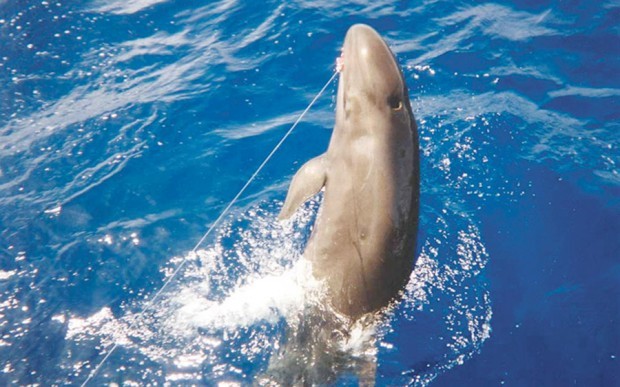HONOLULU — Two conservation groups filed suit Monday in Honolulu’s federal court against the National Marine Fisheries Service and the U.S. Department of Commerce, challenging the agencies’ failure to finalize and implement a plan to protect false killer whales, a
HONOLULU — Two conservation groups filed suit Monday in Honolulu’s federal court against the National Marine Fisheries Service and the U.S. Department of Commerce, challenging the agencies’ failure to finalize and implement a plan to protect false killer whales, a large dolphin species, from the Hawai‘i-based longline fisheries.
The “complaint for declaratory judgment and injunctive relief,” filed by Earthjustice on behalf of the Center for Biological Diversity and the Turtle Island Restoration Network, also identifies as a defendant Rebecca Blank, acting secretary of the Department of Commerce.
“Due to defendants’ longstanding and illegal foot-dragging, the Hawai‘i-based longline fisheries continue to kill and seriously injure false killer whales in Hawaiian waters at rates far beyond what these populations can sustain,” states the lawsuit prepared by Earthjustice, a nonprofit public-interest law firm dedicated to environmental causes.
Congress amended the Marine Mammal Protection Act in 1994, with the goal of achieving zero marine mammal morality in commercial fisheries by 2001. The law establishes clear deadlines for NMFS to take action to protect marine mammals, which the agency routinely ignores, Earthjustice states in a press release Monday.
“Congress understood … time is of the essence if we are going to save marine mammals,” Earthjustice attorney David Henkin said in the release. “But here we are, almost 20 years and a trail of litigation later, and false killer whales are still being needlessly hooked and killed in longline gear.”
According to NMFS’ latest official report, longline fishing is killing false killer whales (Pseudorca crassidens) found within 87 miles of the main Hawaiian Islands — the “Hawai‘i Insular Stock” — at three times the rate this population can sustain, while false killer whales in Hawaiian waters further from shore — the “Hawai‘i Pelagic Stock — are dying at four times sustainable levels, Earthjustice states.
NMFS has proposed listing the Hawai‘i Insular Stock, which numbers only about 170 animals and has been declining by 9 percent per year since 1989, as “endangered” under the Endangered Species Act, Earthjustice states.
NMFS is now six months past its Dec. 16 statutory deadline to finalize a “take-reduction plan” to reduce the killing, according to Earthjustice.
“It’s unconscionable for NMFS to delay action when its own studies show that Hawai‘i’s false killer whales cannot sustain the current level of lethal interactions with the Hawai‘i-based longliners,” said Brendan Cummings of the Center for Biological Diversity.
More than 90 percent of longline fishery interactions lead to death for false killer whales. The animals typically drown when they are hooked by the deep-set fishing lines, which target ahi.
If the false killer whales do escape, they often trail fishing gear that hinders their ability to feed, causing them to die of starvation or infections stemming from their wounds, according to Earthjustice
“These magnificent false killer whales don’t deserve a cruel death at the end of a longline hook, especially since common-sense solutions already exist to prevent serious injuries and drowning,” said Todd Steiner, biologist and executive director of the Turtle Island Restoration Network.
Earthjustice states it went to court on behalf of the conservation groups in 2003 to force NMFS to classify the Hawai‘i longline fisheries as “Category I” due to their unsustainable “take” of false killer whale. NMFS made the classification in 2004, but failed to follow up on the listing by convening a team to develop a take reduction plan, according to Earthjustice.
Another round of litigation followed, and, in January 2010, NMFS established a take reduction team for Hawai‘i’s false killer whales, which included scientists, conservationists, state and federal agencies and fishing industry representatives. Within six months, the team achieved consensus on a draft take reduction plan.
“The team proposed requiring the use of ‘weak hooks’ that would be strong enough to hold an ahi, the fishery’s target species, but weak enough to allow a larger, stronger false killer whale to straighten the hook and pull it out. Of course, this proposal, which the longliners agreed to, won’t do the false killer whales any good unless and until NMFS finalizes the plan,” Cummings said in the release.
In an April 26, 2012 letter to Earthjustice, NMFS regional administrator Michael Tosatto agreed that “conservation needs of false killer whales are of paramount concern.” However, the agency claimed it needed more time to revise its take reduction plan, Earthjustice states.
“Congress understood that no take reduction plan will be perfect when it s issued, and the Marine Mammal Protection Act allows the federal fisheries agency to revise its plans, if warranted,” Henkin said. “The agency cannot, however, completely deprive Hawai‘i’s false killer whales of vital protections while it tinkers. The law imposes deadlines for a reason.”
A December 2008 study by the Government Accountability Office recognized this, saying delays in finalizing take reduction plans “could result in continued harm to already dwindling marine mammal populations.”
“NMFS has known about the false killer whales’ dire plight for years, but has repeatedly refused to take action until forced by litigation,” Steiner said. “That’s why we are headed back to court.”
NMFS did not respond by press time to a late request by The Garden Island for comments.


